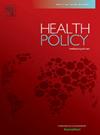审视169个国家的COVID-19死亡率不平等:来自COVID-19死亡率不平等曲线(CMIC)和Theil指数分析的见解
IF 3.4
3区 医学
Q1 HEALTH CARE SCIENCES & SERVICES
引用次数: 0
摘要
2019冠状病毒病大流行凸显了全球卫生结果的差异,死亡率由预先存在的合并症、人口脆弱性和系统性社会经济不平等造成。这些因素突出表明,需要制定以证据为基础的政策,以解决卫生不公平问题并加强系统复原力。本研究量化了169个国家的COVID-19死亡率差异,重点关注肥胖、年龄和收入维度,为公平有效的政策干预提供信息。方法利用公开数据集,采用COVID-19死亡率不平等曲线(CMIC)和指数(CMII)来衡量差异,并用Theil指数将其分解为组内和组间成分。在三个时间点(2020年12月、2021年8月和2022年2月)分析了死亡率数据,以了解疫苗接种运动的影响。结果泰尔指数显示,肥胖率较低(从1.43降至0.80)和人口较老(从0.95降至0.54)的国家的死亡率不平等显著降低,这反映了有针对性的疫苗接种工作的影响。然而,基于收入的差距显示出有限的改善(Theil指数:0.61至0.54),强调了医疗保健获取方面持续存在的不平等。由于早期和广泛接种疫苗,高收入国家在减少不平等方面取得了最显著的成就。结论:在全球危机期间,注重疫苗公平分配、数据协调以及针对肥胖和年龄相关脆弱性的针对性干预措施的量身定制卫生政策对于缩小差距和加强卫生系统的复原力至关重要。本文章由计算机程序翻译,如有差异,请以英文原文为准。
Examining COVID-19 mortality inequalities across 169 countries: Insights from the COVID-19 mortality inequality curve (CMIC) and Theil index analysis
Background
The COVID-19 pandemic has highlighted global disparities in health outcomes, with mortality driven by pre-existing comorbidities, demographic vulnerabilities, and systemic socioeconomic inequalities. These factors underscore the need for evidence-based policies to address health inequities and strengthen system resilience.
Objective
This study quantifies COVID-19 mortality disparities across 169 countries, focusing on obesity, age, and income dimensions, to inform equitable and effective policy interventions.
Methods
Using publicly available datasets, the COVID-19 Mortality Inequality Curve (CMIC) and Index (CMII) were applied to measure disparities, while the Theil Index decomposed them into within- and between-group components. Mortality data were analyzed at three time points—December 2020, August 2021, and February 2022—to capture the effects of vaccination campaigns.
Results
The Theil Index revealed significant reductions in mortality inequality among countries with lower obesity rates (from 1.43 to 0.80) and older populations (from 0.95 to 0.54), reflecting the impact of targeted vaccination efforts. However, income-based disparities showed limited improvement (Theil Index: 0.61 to 0.54), emphasizing persistent inequities in healthcare access. High-income countries achieved the most significant reductions in inequality due to early and widespread vaccination.
Conclusions
Tailored health policies prioritizing equitable vaccine distribution, data harmonization, and targeted interventions for obesity and age-related vulnerabilities are critical for reducing disparities and strengthening health system resilience during global crises.
求助全文
通过发布文献求助,成功后即可免费获取论文全文。
去求助
来源期刊

Health Policy
医学-卫生保健
CiteScore
6.40
自引率
6.10%
发文量
157
审稿时长
3-8 weeks
期刊介绍:
Health Policy is intended to be a vehicle for the exploration and discussion of health policy and health system issues and is aimed in particular at enhancing communication between health policy and system researchers, legislators, decision-makers and professionals concerned with developing, implementing, and analysing health policy, health systems and health care reforms, primarily in high-income countries outside the U.S.A.
 求助内容:
求助内容: 应助结果提醒方式:
应助结果提醒方式:


